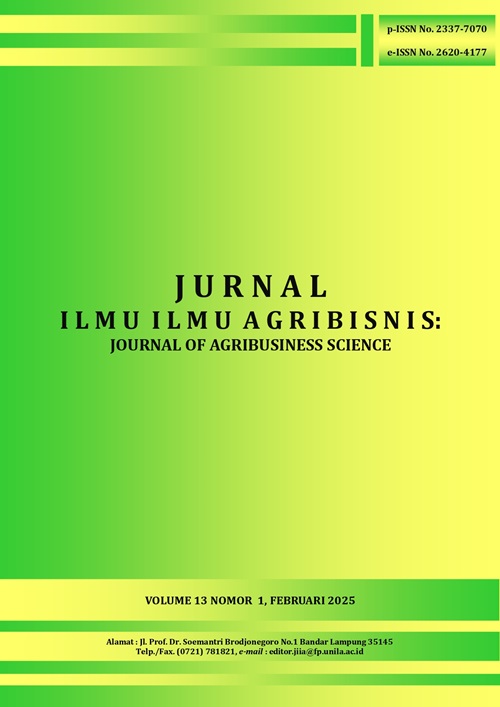PERANAN SUBSEKTOR PERKEBUNAN TEMBAKAU DALAM PEREKONOMIAN KABUPATEN MAGELANG
DOI:
https://doi.org/10.23960/jiia.v13i1.7440 Abstract View: 147
Abstract View: 147
Abstract
Magelang Regency, located in Central Java Province possesses significant potential in various sectors, especially in tobacco cultivation. This study aims to analyze the contribution of tobacco products to the plantation sub-sector in Magelang Regency, analyze the sub-districts as the basis for tobacco products in Magelang Regency, and mapping the sub-districts that have the potential for the tobacco sub-sector in Magelang Regency. A quantitative method was used for this research. This research used secondary data sourced from Badan Pusat Statistik (BPS) of Magelang Regency. Documentation and interviews were conducted as data collection methods. The data analysis technique used in this study consisted of a contribution analysis, Location Quotient (LQ) analysis, Dynamic Location Quotient (DLQ) analysis, and Geographic Information System (GIS) analysis with ArcGIS. The results show that in 2017, the contribution of tobacco products to the plantation sub-sector in Magelang Regencies reached 50.7% and recorded as the highest value compared to other years. The sub-districts that are the basis (LQ≥1) for the tobacco commodity are Sawangan, Kaliangkrik, Windusari, Pakis, and Ngablak. Prospective sub-districts (DLQ≥1) are Borobudur, Ngluwar, Salam, Srumbung, Shaman, Sawangan, Candimulyo, Kajoran, Windusari, Tegalrejo, Pakis, and Grabag Sub-district. The mapping results show that Pakis Sub-district is the most potential sub-district for tobacco commodities.
Keywords : contribution, potential, role, tobacco commodities
Downloads
Downloads
Published
How to Cite
Issue
Section
License
Authors who publish with this journal agree to the following terms:
Authors retain copyright and grant the journal right of first publication with the work simultaneously licensed under a Creative Commons Attribution License that allows others to share the work with an acknowledgement of the work's authorship and initial publication in this journal.
Authors are able to enter into separate, additional contractual arrangements for the non-exclusive distribution of the journal's published version of the work (e.g., post it to an institutional repository or publish it in a book), with an acknowledgement of its initial publication in this journal.
Authors are permitted and encouraged to post their work online (e.g., in institutional repositories or on their website) prior to and during the submission process, as it can lead to productive exchanges, as well as earlier and greater citation of published work (See The Effect of Open Access).














